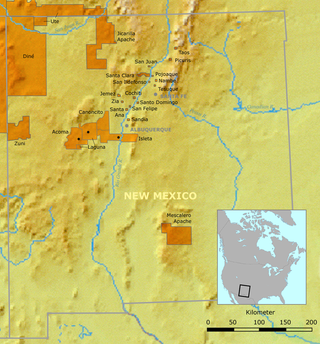
The Puebloans, or Pueblo peoples, are Native Americans in the Southwestern United States who share common agricultural, material, and religious practices. Among the currently inhabited Pueblos, Taos, San Ildefonso, Acoma, Zuni, and Hopi are some of the best-known. Pueblo people speak languages from four different language families, and each Pueblo is further divided culturally by kinship systems and agricultural practices, although all cultivate varieties of maize.
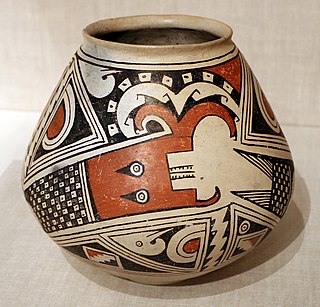
The Horned Serpent appears in the mythologies of many cultures including Native American peoples, European, and Near Eastern mythology. Details vary among cultures, with many of the stories associating the mystical figure with water, rain, lightning, thunder, and rebirth. Horned Serpents were major components of the Southeastern Ceremonial Complex of North American prehistory.
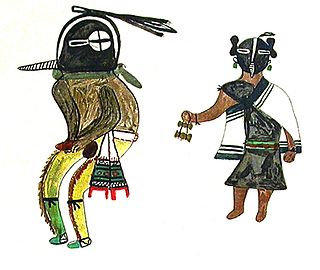
Kokopelli is a fertility deity, usually depicted as a humpbacked flute player, who is venerated by some Native American cultures in the Southwestern United States. Like most fertility deities, Kokopelli presides over both childbirth and agriculture. He is also a trickster god and represents the spirit of music.

The Hopi maintain a complex religious and mythological tradition stretching back over centuries. However, it is difficult to definitively state what all Hopis as a group believe. Like the oral traditions of many other societies, Hopi mythology is not always told consistently and each Hopi mesa, or even each village, may have its own version of a particular story, but "in essence the variants of the Hopi myth bear marked similarity to one another." It is also not clear that the stories told to non-Hopis, such as anthropologists and ethnographers, represent genuine Hopi beliefs or are merely stories told to the curious while keeping safe the more sacred Hopi teachings. As folklorist Harold Courlander states, "there is a Hopi reticence about discussing matters that could be considered ritual secrets or religion-oriented traditions."

Santa Clara Pueblo ″Singing Water Village″, also known as ″Village of Wild Roses″ is a census-designated place (CDP) in Rio Arriba County, New Mexico, United States and a federally recognized tribe of Native American Pueblo people.

Pojoaque, Po’su wae geh, which translates to “water gathering place”, is a census-designated place (CDP) in Santa Fe County, New Mexico, United States. It is part of the Santa Fe, New Mexico Metropolitan Statistical Area. The population was 1,907 at the 2010 census. Pojoaque Pueblo, a neighboring community, is an Indian reservation, and the town of Pojoaque is a collection of communities near the pueblo with people from various ethnic backgrounds. The area of Pojoaque includes the neighborhoods of Cuyamungue, Jacona, Jaconita, Nambé and El Rancho.

San Ildefonso Pueblo is a census-designated place (CDP) in Santa Fe County, New Mexico, United States, and a federally recognized tribe, established c. 1300 C.E. The Pueblo is self-governing and is part of the Santa Fe, New Mexico Metropolitan Statistical Area. The population was 524 as of the 2010 census, reported by the State of New Mexico as 1,524 in 2012, and there were 628 enrolled tribal members reported as of 2012 according to the Department of the Interior. San Ildefonso Pueblo is a member of the Eight Northern Pueblos, and the pueblo people are from the Tewa ethnic group of Native Americans, who speak the Tewa language.

The Tewa are a linguistic group of Pueblo Native Americans who speak the Tewa language and share the Pueblo culture. Their homelands are on or near the Rio Grande in New Mexico north of Santa Fe. They comprise the following communities:

K’uk’ulkan, also spelled Kukulkan, is the Mesoamerican serpent deity of the Pre-Columbine Yucatec Maya. It is closely related to the deity Qʼuqʼumatz of the Kʼicheʼ people and to Quetzalcoatl of Aztec mythology. Prominent temples to Kukulkan are found at archaeological sites in the Yucatán Peninsula, such as Chichen Itza, Uxmal and Mayapan.

Casas Grandes is a prehistoric archaeological site in the northern Mexican state of Chihuahua. Construction of the site is attributed to the Mogollon culture. Casas Grandes has been designated a UNESCO World Heritage Site under the purview of INAH and a "Pueblo Mágico" since 2015.

El Cuartelejo, or El Quartelejo, is a region in eastern Colorado and western Kansas where Plains Apache cohabited with Puebloans. Subject to religious persecution, Puebloans fled the Spanish Nuevo México territory and cohabitated with the Cuartelejo villagers in the 1600s.

Snakes are a common occurrence in myths for a multitude of cultures. The Hopi people of North America viewed snakes as symbols of healing, transformation, and fertility. In other cultures snakes symbolized the umbilical cord, joining all humans to Mother Earth. The Great Goddess often had snakes as her familiars—sometimes twining around her sacred staff, as in ancient Crete—and they were worshipped as guardians of her mysteries of birth and regeneration. Although not entirely a snake, the plumed serpent, Quetzalcoatl, in Mesoamerican culture, particularly Mayan and Aztec, held a multitude of roles as a deity. He was viewed as a twin entity which embodied that of god and man and equally man and serpent, yet was closely associated with fertility. In ancient Aztec mythology, Quetzalcoatl was the son of the fertility earth goddess, Cihuacoatl, and cloud serpent and hunting god, Maxicoat. His roles took the form of everything from bringer of morning winds and bright daylight for healthy crops, to a sea god capable of bringing on great floods. As shown in the images there are images of the sky serpent with its tail in its mouth, it is believed to be a reverence to the sun, for which Quetzalcoatl was also closely linked.

Maria Poveka Montoya Martinez was a Native American artist who created internationally known pottery. Martinez, her husband Julian, and other family members, including her son Popovi Da, examined traditional Pueblo pottery styles and techniques to create pieces which reflect the Pueblo people's legacy of fine artwork and crafts. The works of Maria Martinez, and especially her black ware pottery, survive in many museums, including the Smithsonian, the Metropolitan Museum of Art, the Denver Art Museum, and more. The Penn Museum in Philadelphia holds eight vessels – three plates and five jars – signed either "Marie" or "Marie & Julian".
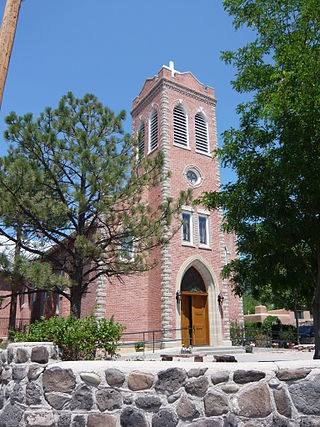
Ohkay Owingeh, known by its Spanish name as San Juan de los Caballeros from 1589 to 2005, is a pueblo and census-designated place (CDP) in Rio Arriba County, New Mexico. Ohkay Owingeh is also a federally recognized tribe of Pueblo people inhabiting the town.

Oasisamerica is a term that was coined by Paul Kirchhoff and published in a 1954 article, and is used by some scholars, primarily Mexican anthropologists, for the broad cultural area defining pre-Columbian southwestern North America. It extends from modern-day Utah down to southern Chihuahua, and from the coast on the Gulf of California eastward to the Río Bravo river valley. Its name comes from its position in relationship with the similar regions of Mesoamerica and mostly nomadic Aridoamerica. The term Greater Southwest is often used to describe this region by American anthropologists.

The Feathered Serpent is a prominent supernatural entity or deity, found in many Mesoamerican religions. It is still called Quetzalcoatl among the Aztecs, Kukulkan among the Yucatec Maya, and Q'uq'umatz and Tohil among the K'iche' Maya.
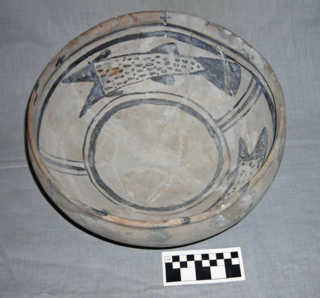
The Rio Grande white wares comprise multiple pottery traditions of the prehistoric Puebloan peoples of New Mexico. About AD 750, the beginning of the Pueblo I Era, after adhering to a different and widespread regional ceramic tradition for generations, potters of the Rio Grande region of New Mexico began developing distinctly local varieties of black-on-white pottery. This pottery involved the use of black mineral paint or black vegetal paint on a white, off-white, or light gray background. The black-on-white tradition finally died out about AD 1750.

Quetzalcoatl is a deity in Aztec culture and literature. Among the Aztecs, he was related to wind, Venus, Sun, merchants, arts, crafts, knowledge, and learning. He was also the patron god of the Aztec priesthood. He was one of several important gods in the Aztec pantheon, along with the gods Tlaloc, Tezcatlipoca and Huitzilopochtli. Two other gods represented by the planet Venus are Tlaloc and Xolotl.
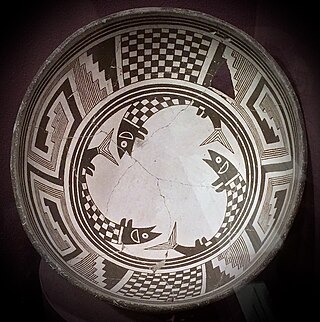
Pueblo pottery are ceramic objects made by the indigenous Pueblo people and their antecedents, the Ancestral Puebloans and Mogollon cultures in the Southwestern United States and Northern Mexico. For centuries, pottery has been central to pueblo life as a feature of ceremonial and utilitarian usage. The clay is locally sourced, most frequently handmade, and fired traditionally in an earthen pit. These items take the form of storage jars, canteens, serving bowls, seed jars, and ladles. Some utility wares were undecorated except from simple corrugations or marks made with a stick or fingernail, however many examples for centuries were painted with abstract or representational motifs. Some pueblos made effigy vessels, fetishes or figurines. During modern times, pueblo pottery was produced specifically as an art form to serve an economic function. This role is not dissimilar to prehistoric times when pottery was traded throughout the Southwest, and in historic times after contact with the Spanish colonialists.






















